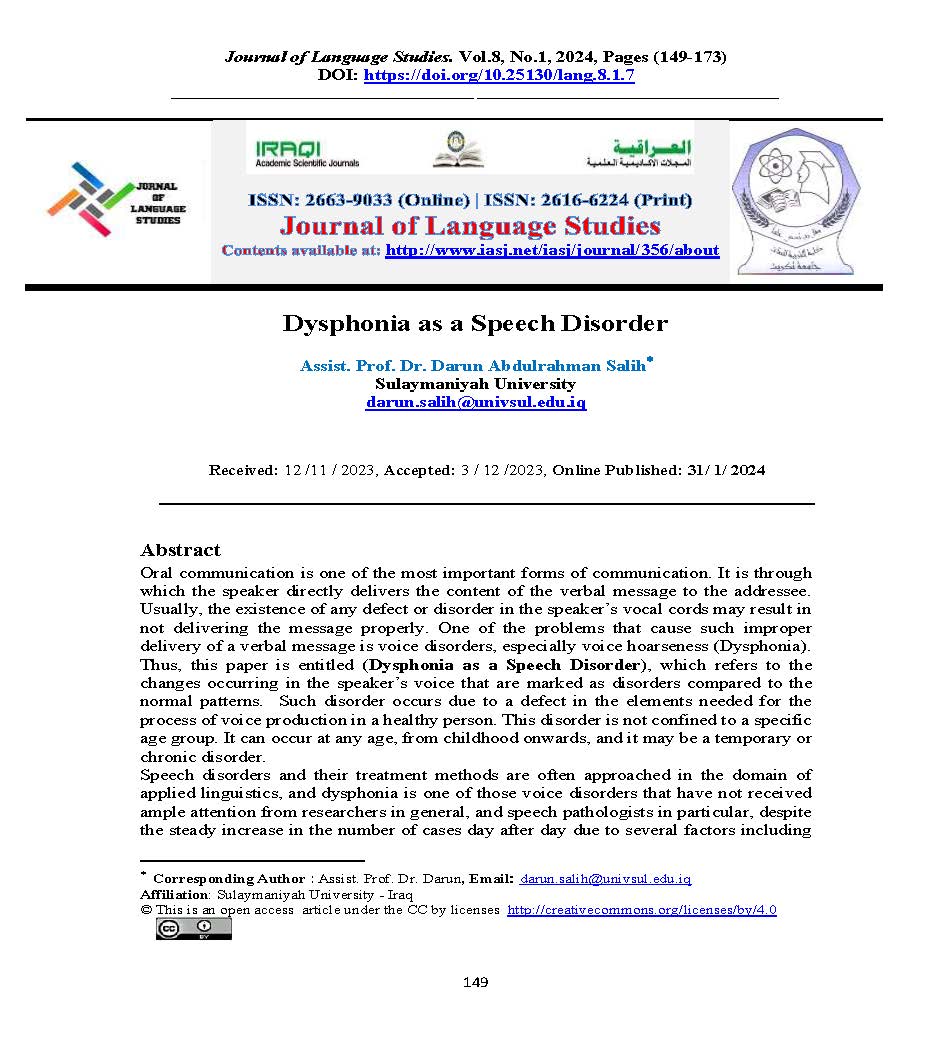Dysphonia as a Speech Disorder
DOI:
https://doi.org/10.25130/lang.8.1.7Keywords:
voice hoarseness (dysphonia), speech disorders, vocal cords, neurolinguisticsAbstract
Oral communication is one of the most important forms of communication. It is through which the speaker directly delivers the content of the verbal message to the addressee. Usually, the existence of any defect or disorder in the speaker’s vocal cords may result in not delivering the message properly. One of the problems that cause such improper delivery of a verbal message is voice disorders, especially voice hoarseness (Dysphonia). Thus, this paper is entitled (Dysphonia as a Speech Disorder), which refers to the changes occurring in the speaker’s voice that are marked as disorders compared to the normal patterns. Such disorder occurs due to a defect in the elements needed for the process of voice production in a healthy person. This disorder is not confined to a specific age group. It can occur at any age, from childhood onwards, and it may be a temporary or chronic disorder.
Speech disorders and their treatment methods are often approached in the domain of applied linguistics, and dysphonia is one of those voice disorders that have not received ample attention from researchers in general, and speech pathologists in particular, despite the steady increase in the number of cases day after day due to several factors including the noise pollution and crowdedness in cities, and some everyday duties that cause injury, which then can be an effective factor for this disorder to occur.
Hence, this study is determined to introduce the most important modern trends in rehabilitating voice disorders and presenting methods for curing them.
References
لەكۆتایی ئەم توێژینەوەیەدا گەیشتینە ئەم ئەنجامانەی لای خوارەوە:
- دەنگنوسان بەیەكێك لەنەخۆشیەكانی گوتن و تێكچوونی دەنگ دادەنرێت، كە بریتیە لەو گۆڕانكارییە دەنگیانەی بەهۆی بوونی گرفت لەپێكهاتەی بەرهەمهێنانی دەنگ لەكەسێكی تەندروستدا ڕوودەدات. نەخۆشی دەنگنوسان پوەست نیە بەتەمەنێكی دیاریكراوەوە، بەڵكو ئەگەڕی ڕوودانی لەهەموو تەمەنێكدا هەیە، هەروەها لەهەردوو ڕەگەزیشدا ڕوودەدات.
- ئەو كەسانەی زیاتر ڕووبەڕووی نەخۆشیی دەنگنوسان دەبنەوە، ئەوانەن كە زیاتر دەنگیان بەكاردەهێنن، واتە ئەوانەی پیشەكەیان پەیوەستە بەدەنگیانەوە، هەربۆیە بەكارهێنانی دەنگ بەشێوەیەكی زۆر پێویستی بەكۆمەڵێك ڕێوشوێنی دیاریكراو هەیە، كە پێویستە پەنای بۆ ببرێت لەڕێگەی خۆپاراستنەوە.
- نەخۆشیی دەنگنوسان خۆی لەدوو جۆرو هۆكاردا دەبینێتەوە، ئەوانیش: نەخۆشیی دەنگنوسانی ئەندامی و نائەندامی (ئەركی)یە، كە زۆربەی زۆری نەخۆشەكان لەجۆری نائەندامین، ئەمەش بەهۆی بەكارهێنانی دەنگیانەوەیە بەشێوەیەكی هەڵە.
- پەنابردنەبەر باوترین و گرنگترین ڕاهێنانە دەنگیەكان، بەسەرەكیترین و باشترین چارەسەری دەنگیی دادەنرێن لەلایەن ڕاهێنەری دەنگیەوە، كە پێویستە نەخۆشەكە پابەندبێت بەسەرجەم ڕێنمایی و كاتی سەردان و ڕاهێنانەكانەوە.
Reference kurdish language
- Deziyi, Abdel Wahed Mushir. Muhammad, Dana Tahsin. Salih, Darun Abdulrahman (2015), Art and Technology, Edition 2, Chap Khan, Hevi, Holler.
- Hamid, Yara Qadir (2015), Gyrograph and the text of Gutun and Jaraskardinian, The Russian Federation of Chinese Languages. Howler.
- Mohamed, Dana Tahsin (2008), we have no idea how to change the language, Master’s Thesis, university of Salahdin, Howler.
- Wahid, Sakar Kamal (2013), How to change the meaning of the time frame (for example, pragmatics), Master’s Thesis, university of Salahdin, Howler.
- Weiss, Ghazi Fatih (1984), Art, Technology, Technology, Technology, and Technology, Howler.
Reference Arabic language
- Abu Zaid, Nabila Amin (2011), Disorders of Speech and Intelligible Speech - Diagnosis - Treatment, World of Books, Cairo.
- Baya, Zaidi (2013), Speech and Language Disorders, Journal of Linguistic Practices, Mouloud Mammeri University of Tizi Ouzou, Issue 19, Algeria.
- Doria, Sabiq (2014), Proposing a cost protocol for hoarseness disorder among voice professionals, Master’s Thesis, Larbi Ben Mhidi University Oum El Bouaghi, Faculty of Social and Human Sciences.
- Al-Zuraikat, Ibrahim Abdullah Faraj (2005), Speech and Language Disorders - Diagnosis and Treatment -, Dar Al-Fikr.
- Shash, Suhair Muhammad Salama (2007), Communication Disorders (Diagnosis - Causes - Treatment), Zahraa Al-Sharq Library, Cairo.
- Al-Abdullah, Salama (2015), Voice Disorders, Amjad Publishing and Distribution House, Amman-Jordan.
- Al-Afif, Faisal (D.D.), Speech and Language Disorders, Arab Book Library, D.D.: 23.
- Ali, Kaddour (2012), Developing an informational therapeutic protocol based on the principle of visual feedback to deal with voice disorders: Vocal tendon paralysis, Master’s degree, University of Algiers 2, Faculty of Social and Human Sciences, Department of Psychology, Educational Sciences, and Orthopedics.
Reference English language
- Ahlsen Elesabith ( 2006), Introduction to Nerolinguistics, Goteborg university, amestdam- Philadelphia, John Benjamins puplished.
- Boyle, B. (2000), Voice disorders in children, Juppor for learning, Vol.15, No.2.
-Davis, C.N. & Harris, T.B. (1992), Teachers ability to accurately identify disordered voices. Zanguage, Speech & Hearing Services in Schools, Vol.23, No.2, April.
- David Howard, www.britishlaryngological.org/patient-information/hoarse-voice.
- David Kammerer, (2014), Nerolinguistics:Mind, Brain, and Language, department of speech, Language and Hearing, science, purdue university, west Lafayette, USA, 14 May.
- Jean a Rondal & Xavier Seron ,(2003), troubles du langage Mardaga,Liège, Belgique.
- Jan-ola ostman & Jef Verschueren, (2012), Nerolinguistics, Handbook of pragmatics.
-Lu, D., Huang, M., Cheng, I. k., Dong, J., & Yang, H. (2018), Comparison and correlation between the pediatric Voice Handicap Index and the pediatric voice-related quality-of-life questionnaires. Medicine, Baltimore,Vol.97, No.36, Sep 7.
- Mathieson, L. (1995), Some standards and outcomes for a combind ENT/Speech therapy voice clinc- Apreliminary audit survey, International journal of language & communication disorders, Vol. 30, Issue S1.
- Niedzielska G,(2001), Acoustic analysis in the diagnosis of voice disorders in children, International Journal of pediatric otorhinolaryngology, v.57.Issua 3/ 1 march.
-Whitaker, H.A & Brigitte Stemmer, (1998), handbook of Neurolinguistics, Academic press, London.
- Wright, J.A.& Graham.J. (1997), Where and when do speech and language therapists work with teachers. British Journal of Special Education.

